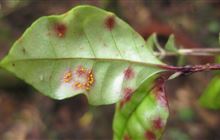New approach to manage myrtle rust
Archived content: This media release was accurate on the date of publication.
Introduction
The fight against the plant disease myrtle rust is changing gear, with a greater focus on a science programme to increase our understanding around the disease.Date: 06 April 2018 Source: Department of Conservation and Ministry for Primary Industries
The Ministry for Primary Industries (MPI) and the DOC say the fight against the plant disease myrtle rust is changing gear, given the prevalence of the disease across susceptible parts of New Zealand.
Myrtle rust has now been confirmed in the Tasman region at the top of the South Island, which means the disease has been found across almost all regions identified as most vulnerable based on habitat suitability and wind patterns.
“When myrtle rust was first discovered on mainland New Zealand in May last year, we said it would be a challenging disease to contain and eradicate but we would give it a good crack,” says MPI Myrtle Rust Response Spokesperson Dr Catherine Duthie.
“There has been an enormous operational effort over the last 11 months, but the windborne nature of the disease means that containment has not proved possible. We have signalled for a while the likely need to change gear from intensive surveillance and the removal and destruction of host plants, to one where we look to manage the disease over the long term.”
The fungus has been found in Tasman region on ramarama (Lophomyrtus) on a residential property in Collingwood in Golden Bay, and a commercial property at Pohara. In addition, MPI has confirmed infections on five properties at Omori on the south-western edge of Lake Taupo, which is also a new region for infection.
“We now have well over 540 infected sites across the North Island and now the top of the South,” says Dr Duthie. “Because of the windborne, pernicious nature of the disease, we have to anticipate that there are likely to be many more infected sites beyond these.”
Dr Duthie says the focus of efforts now had to be placed on a science programme designed to lift our understanding around the disease such as ways to treat myrtle rust, resistance and susceptibility, and to improve seed banking collection.
“A second key focus has to be on working with communities across New Zealand to support regional efforts to combat myrtle rust. As we transition to long term management, MPI and DOC will be engaging with iwi and hapū, territorial authorities, the plant and nursery industries, and communities to support the development of regional programmes. This could include regional surveillance programmes, identification and protection strategies for taonga plants and special locations, advice to landowners, seed banking, and broad community engagement.”
As part of involving and informing communities at the grassroots, MPI and DOC will hold hui with iwi and councils in affected regions over the coming months.
“We think this regional and community effort is really important. One of the most critical things is for people to continue to report suspected infections. We need to keep tracking the spread of the disease so we can better understand how it might behave in New Zealand and what its long-term impacts might be. This will help us to understand resistance of native species and will be vital to our myrtle rust science programme.”
More than 540 properties are known to have been infected by the fungal disease since it was first detected on mainland New Zealand in mid-May 2017. Since then, more than 5000 myrtle plants have been securely removed and destroyed, and more than 95,000 myrtle plants inspected.
Members of the public are encouraged to continue to report any possible cases to the Biosecurity Hotline 0800 80 99 66.
DOC will continue to focus on seed collection to secure the long-term future of native myrtle plants and monitoring biodiversity impacts to inform science and management actions. It will also continue efforts to protect sites of high ecological and cultural significance.
Contact
Victoria Moss, MPI Senior Communications Adviser
Email: victoria.moss@mpi.govt.nz

